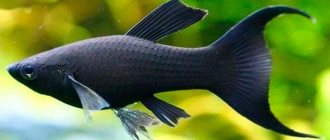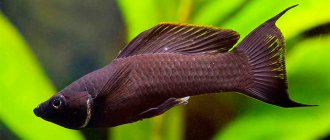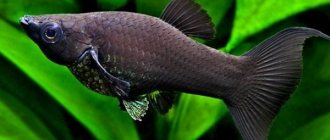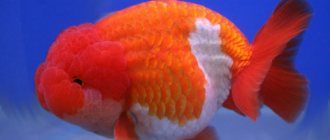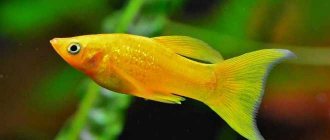Mollies (lat. Mollienesia) are the best choice for beginner aquarists. These fish have many advantages - they are unpretentious, friendly and omnivorous. In the wild, mollies live in fresh and brackish waters of Central America. Wild species are divided into two groups: those with short fins and those with long fins. Fish first appeared in aquariums in 1899. A wide variety of colors, shapes and sizes have been obtained through selective breeding, but three species are most often found in aquariums: Molliesia velifera, Molliesia sphenops and Molliesia latipinas. Hybridization for the purpose of breeding new breeds is still relevant today.
Known species of mollies
Molliesia Velifera. It is distinguished by a well-developed dorsal fan-shaped fin in the male. The body size can reach up to 5 cm. The natural color of the body is silver with horizontal dotted lines, the front part of the body is sometimes painted a pleasant orange color. The tail is turquoise on the periphery and orange in the middle. Females have a grey-green body. The fish is very active and requires a large space for swimming. In its natural environment it feeds on mosquito larvae. Loves slightly salty water.
Molliesia sphenops. It has a dense, elongated and laterally compressed body, a well-developed round fin. Body size: 6-10 cm. The most popular color is pure black. But there are artificially produced white, yellow and speckled ones. The most valuable are considered to be mollies with black velvet scales, whose large black eyes are practically invisible. Sphenops swims preferably in the upper and middle layers of water. They often jump out of aquariums that are not covered with a lid.
Molliesia latipin. It is very similar to the Velifera molly, but is smaller in size. The color is most often bluish-gray. Males are more greenish. The sides are strewn with shiny white dots arranged in rows. The lower part of the body is bright orange.
Description
Valued for its unusual color, ability to reproduce in a community aquarium, and livability.
Appearance
The body is elliptical, elongated. Laterally compressed. The mouth is large, oriented upward. The color of the body and fins is velvety black. Aquarists consider the presence of light spots to be a defect.
The latest achievement of breeders is the tail fin of the black molly in the shape of a rotated letter “Ω”. The ends are pointed. There are varieties with the dorsal fin extended towards the tail.
Males grow up to 50–60 mm, females – up to 60–80 mm.
Lifestyle
They are mobile in all areas of the aquarium and playful. Males are especially active. In an overcrowded tank and when there is a shortage of females, they are aggressive towards their relatives and defend the territory. Keep at a rate of 2 females to 1 male.
The situation is similar with a lack of food. Only females show aggression.
In nature, they are schooling fish. In captivity, gregariousness is less pronounced.
Lifespan
The black molly fish lives 3–3.5 years.
Maintenance and care
As mentioned earlier, due to their simplicity and unpretentiousness, mollies are suitable for keeping by beginning aquarists. They are able to adapt to a wide range of water parameters. But it is still recommended to maintain the most optimal conditions in the aquarium. The water temperature should be 23-28 degrees. Both neutral and slightly acidic water (pH= 7-8) is suitable. They feel great in hard water.
The ideal volume of an aquarium is 50-70 liters, depending on the number of fish living in it. The aquarium must be provided with good filtration and the water must be changed regularly. Fish are light-loving, so take care of bright lighting.
Mollies love to eat the leaves of some plants and scrape algae from the surface of decorations and soil. It will be useful to plant the aquarium with live plants. Sand or fine gravel is ideal as a soil.
Feeding
Black molly is an omnivorous fish. Relatives in nature feed more on plant food. Aquarium hybrids need a varied diet.
Feed 1-2 times daily. In addition to the mandatory fasting day.
Live food
Bloodworms and tubifex are high in calories and contain essential substances and vitamins. Regular eating causes obesity. They are mined at the bottom of standing reservoirs. There is a risk of introducing parasites and infections, and fish poisoning.
The coretra is not so dangerous because it lives and feeds in the water column. Not as nutritious.
Daphnia, gammarus and brine shrimp are bred at home. Experienced aquarists solve the problem of the safety of live food in this way. Nauplii, Artemia larvae, are used to feed the fry.
- Live food contains nutrients and beneficial substances in a form accessible to fish.
- Uneaten, does not spoil water.
- Caught in dirty waters is dangerous.
Frozen food
Safe against infections and parasites. Even products from trusted manufacturers poison fish. During storage and delivery, there is a possibility of defrosting, which is unacceptable.
- Contains the same ingredients as live food.
- It is necessary to siphon off the remains.
- Risks poisoning.
Dry food
It is produced in the form of powders, flakes and tablets. The food is balanced and contains vitamins, micro- and macroelements. Manufacturers:
- Hikari;
- Zoomworld;
- Tropical;
- Aller Aqua;
- TETRA;
- SERA;
- JBL.
If you are leaving, install an automatic feeder with a timer.
- No preparation required.
- Contains the necessary ingredients.
- Safe.
- The presence of the owner is not required.
- Residues must be removed.
Plant food
- Black mollies need plant fiber. Plant food makes up 30% of the diet.
- Spirulina tablets and flakes. Spirulina is a cross between a bacterium and an algae. This makes the composition specific. Not enough fiber (9-11%). The vitamins, micro- and macroelements contained will strengthen the immune system. Blanched vegetables - cucumber, zucchini, cabbage. Spinach and greens will do. Dried nettle is rich in vitamins.
- Crushed and blanched oat flakes (“Hercules”), semolina.
Top dressing
Used to diversify the diet. Feed with hard-boiled chicken egg yolk. Chopped boiled meat, liver. Chopped sea fish. Raw river fish should not be given due to the presence of parasites and infections.
General recommendations
- None of the listed foods are suitable for constant feeding. Diversify your diet.
- A lack of plant food in the diet will affect the condition of the plants. The black molly will eat the algae and attack the grass.
- Overfeeding threatens gastrointestinal disorders and obesity. Don't forget about fasting days.
- Remove uneaten food. It spoils the water and provokes the growth of algae.
How do they reproduce?
Breeding mollies requires virtually no effort; even a beginner can handle it.
The fish are viviparous - the fry is born fully formed and capable of independent life.
Pregnancy is determined by several signs: a swollen abdomen, an enlarged dark spot near the anus, swelling of the anus, and frequent solitude of the female in dense vegetation. Female mollies are highly fertile. The age and size of the female affects the number of fry (50 – 350 fry). To prevent the newborn fry from being eaten by other inhabitants of the aquarium, it is better to place the pregnant female in a separate spawning aquarium, or to provide the offspring with a large number of different shelters and plants.
Pregnant female molly
Natural forms of molly
Nature has created only a few forms of mollies, whose natural habitat was the waters of Central and South America.
The conditions of maintenance and care of all types are the same. Mollies prefer to live in fresh or slightly brackish water, the temperature of which is between 25-28. Diseases in molly are rare. The molly diet can consist of both plant foods (algae, lettuce) and live food (bloodworms, mosquito larvae, earthworms).
Molly fish are quite peaceful and easily get along with many representatives of other species. Mollies are viviparous species, which is especially pleasing to aquarists.
Most species have an elongated body with flattened sides. The shape, size and color of the fins depend on the species of the individual.
Mollies sphenops (Poecilia sphenops)
Molly Sphenops, like most mollies, has a dense, elongated body with flat sides. On a relatively small head, large eyes and a slightly upturned mouth stand out. Thanks to this shape of the lips, the fish is able to obtain food from the surface of the water and scrape off algae.
The fins of Sphenops are small, which is why this fish is considered to have few fins. The widest and most beautiful is the caudal fin. The anal fin, as a result of changes that occurred in the structure, was transformed into a gonopodium (sexual organ). The third ray of the gonopodium is equipped with a membranous hook intended for fertilization of the female.
Male platies are much smaller than females and have a less pronounced abdomen. Females living in natural conditions reach 10-12 cm, in captivity the size of fish does not exceed 10 cm. Males in nature grow up to 8 cm, and in an aquarium - up to 6 cm.
The natural color of the molly sphenops is unattractive. The upper half of the body is colored grayish-greenish; in the lower part of the body, shades of scales vary from gray to silver. A scattering of black spots is scattered throughout the body. It is almost impossible to find fish with natural colors on the market.
Free mollies (Poecilia salvatoris)
The native habitat of these fish is the waters of Guatemala. Free Molly was long considered one of the morphs of Molliesia Sphenops, but was soon identified as a separate species.
Wild individuals of Salvatoris are distinguished by differences in the color of the body and fins. The scales on the body of the fish are colored silver-yellow. The fins on the abdomen and back, as well as the tail of the free-ranging mollies are more colorful. They can be orange or red with black spots. But only males have such colorful fins; the fins of females are less expressive. Moreover, the older the males are, the brighter their color.
This fish is rarely found in aquariums. This is explained by the fact that due to unsuitable living conditions, the color of this species of molly faded over time, the fish became colorless, and people stopped being interested in it.
In recent years, aquarists have again become interested in free-ranging mollies, since they are more unpretentious than their counterparts. Unlike other forms of mollies, free mollies can survive on fresh water.
Peten (Mollinesia petenensis)
This fish got its name from its habitat – Lake Petén in Guatemala. Due to the black xiphoid process on the lower blade of the caudal fin, the Petena is often mistaken for a swordtail. The body is covered with mother-of-pearl scales. Along the edge of the fins, also shimmering with mother-of-pearl, there is a reddish edging.
Aquarists breed mainly the velvety black Peten variety, obtained artificially. But even pure black individuals often give birth to fry covered with silver or bluish-green scales.
Swallow molly or velifera (Poecilia velifera)
This fish is native to Southern Mexico. It gets its name from its fan-shaped dorsal fin, which resembles a sail. The sailing platie is the largest and most colorful species of this genus. The length of wild males reaches 20 cm, in the aquarium their size is slightly smaller - 12-14 cm.
The body of the fish can be painted in different colors: gray-green, bluish, silver. Shiny dots of the same color, but of a more saturated tone, are scattered throughout the body, merging into lines parallel to each other.
The sail-shaped fin consists of 18-19 rays. The upper edge of the fin is bordered by a stripe of orange, red and bluish colors.
The caudal fin is no less colorful and has a rounded shape. The surface of the fin is covered with blue shining dots. The bluish color of the fin becomes reddish-black closer to the edge. Females lack a sail-like fin and are much paler in appearance than males.
Velifera is able to maintain its luxurious sail only with proper care. In the absence of appropriate conditions, the fish lose their main decoration - a lush fin.
The large size of the fish requires an aquarium with a volume of about 100 liters. The sailing molly prefers calm neighbors. Aggressive representatives of waterfowl can deprive the molly of its colorful fin by plucking it.
Dwarf molly
In the reservoirs of Mexico, small individuals of mollies, called dwarf mollies, are often found. Their sizes do not exceed 3-4 cm. The sides of the light brown body of the fish are covered with golden dots. The scales of the dominant male have a blue metallic sheen.
Unlike their counterparts, dwarf mollies feel no less comfortable in water, the temperature of which ranges from 17-31 degrees. But they are more sensitive to lack of oxygen and require frequent water changes.
Latipin molly (Poecilia latipinna)
The second name of this fish is the broad peacock molly. This species is found in Southeast and Southwest America. Externally, Latipine is similar to Velifera, but smaller in size.
More than a dozen rays on the back form a high rectangular fin. A well-developed caudal fin has a rounded shape.
The body of the fish is covered with bluish-gray scales. The sides of males may be greenish-brown. Whitish shiny dots running along the sides form symmetrical rows. The neck and breast are yellowish-golden in color. The dorsal fin is framed by a reddish border. Multi-colored inclusions are scattered across the entire surface of the fin. The color of the female is practically no different from the males, only the colors are slightly paler.
Wild letipina are rarely seen in aquariums. Its hybrid form is mainly bred.
How to distinguish a male from a female
The choice of a pair of sires plays an important role in obtaining healthy offspring. This is not difficult, since mollies have pronounced sexual dimorphism. As a rule, males are much smaller than females and have a mobile gonopodium - a modified anal fin that serves as a reproductive organ. Sexual maturity in fish occurs at 8-12 months for males, and at 5-6 months for females. When selecting, you need to pay attention to the strongest, most active and beautiful individuals.
Is it possible to find out the sex of the fry?
Immediately after birth, regardless of gender, baby mollies will have an expanded anal fin. It is simply impossible to accurately distinguish a female from a male. The fry are about 6 mm in size, translucent. Immediately after birth, they do not swim, but lie on the bottom of the aquarium for some time.
Visually, the entire young generation looks exactly like females. They do not display distinct sexual characteristics. Around the end of the first month and before the beginning of the third month of a fish’s life, the sex of the fish can be determined.
Diseases
Even such unpretentious fish are vulnerable to some diseases:
• Gas embolism – accumulation of excess oxygen and further blockage of blood vessels. The fish becomes restless, the gill covers gradually darken, sometimes the eyes become cloudy and bruises are visible. The disease occurs when a large volume of tap water is poured into an aquarium without first settling. For prevention, it is necessary to settle the water to fill the aquarium. • Colds - accompanied by refusal to eat and decreased activity. Occurs when the temperature drops sharply. It is treated by maintaining a constant optimal water temperature in the aquarium. • Infestation – when infected with parasites, the fish begins to worry, and a painful coating appears on the surface of the body. In case of such diseases, water is treated with special preparations. • – sick fish experience changes in behavior and appearance. Treatment is selected depending on the type of infectious disease.
Reproduction of Mollies in a community aquarium
The ability to create offspring occurs at the age of 8-12 months. For the breeding process in an aquarium, 2-3 females are calculated for each male. Fertilization occurs in a spacious tank, in warm salted water. Since all platies are classified as viviparous fish, fry are born without going through the egg stage. The male immediately fertilizes all the eggs available to the female Molly.
During pregnancy, Mollies get fatter, darkening becomes noticeable on the belly, and the activity of the fish decreases. The female increasingly hides in the greenery away from her neighbors, looking for a secluded corner. Pregnancy lasts about 1.5 months. The female can be placed in another aquarium or in a nursery, which is located in a common aquarium.
One female can give birth to 20-150 fry (depending on the type and size of Mollies).
Reference! Monitor any temperature changes and change the water promptly, otherwise the platies will not be able to reproduce healthy fish or will get sick. The saddest outcome is that the female may give birth to dead fry.
Compatibility with other fish
Thanks to their boundless friendliness, mollies are ideal for keeping in a community aquarium and are compatible with all peaceful fish. But it is important to consider that they cannot be kept together with predatory or aggressive species. Fights may occur between male mollies.
Ideal neighbors: • Guppies • Swordtails • Danios • Corydoras
Mollies are very popular among aquarists. Various exhibitions and scientific conferences are held around the world, where you can see the best representatives of various breeds and color variations. Due to their unpretentiousness in maintenance and care, such fish are ideal for the very first aquarium in your life.
Video “Golden molly with other inhabitants of the aquarium”
The friendly golden molly will be a bright decoration in a community aquarium, and the young animals being raised can be placed close to their parents. Watch the video from the Alex Vlas channel to enjoy the sight of these small and nimble fish.
Was this article helpful?
Thank you for your opinion!
The article was useful. Please share the information with your friends.
Yes (100.00%)
No
X
Please write what is wrong and leave recommendations on the article
Cancel reply
Rate the benefit of the article: Rate the author ( 4 votes, average: 5.00 out of 5)
Discuss the article:
Popular breeding forms of mollies
Golden - have a bright yellow-orange color, which has a white-blue tint. Some individuals have red eyes.
Silver (another name for Snowflakes) - the body is painted white with a beautiful silver tint. They sparkle like snow in the sun, which was the reason to call them snowflakes.
Balloon - characteristic features of this breed are a swollen abdomen and a shortened shape. The color can be different - from orange and red to white and black.
Mollies with a lyre tail - the tail has a lyre shape, which gives it originality. The length of the tail rays may vary.



